Virus
![]()
The title of this article is ambiguous. For other meanings, see Viruses (disambiguation).
Viruses (singular: the virus, outside technical language also the virus, from Latin virus 'natural viscous moisture, mucus, juice, [especially:] poison') are infectious organic structures which, as virions, spread outside cells (extracellular) by transmission, but, as viruses, can only multiply within a suitable host cell (intracellular). They do not themselves consist of one or more cells. All viruses contain the program for their replication and spread (some viruses also contain other auxiliary components), but have neither independent replication nor their own metabolism and are therefore dependent on the metabolism of a host cell. Therefore, virologists largely agree not to count viruses as living organisms. However, they can at least be considered "close to life" because they generally possess the ability to control their replication and the ability to evolve.
In 2011, about 1.8 million different recent species of living organisms were known to act as hosts for viruses, but only about 9110 virus species. Viruses infect cells of eukaryotes (plants, fungi and animals including humans) and prokaryotes (bacteria and archaea). Viruses that use prokaryotes as hosts are called bacteriophages, but viruses that specifically infect archaea are sometimes called archaeophages.
The science that deals with viruses and viral infections is called virology.
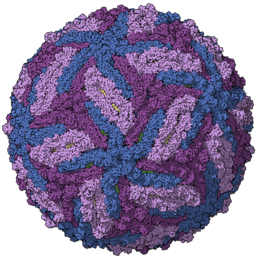
Capsid of the zika virus, coloured model
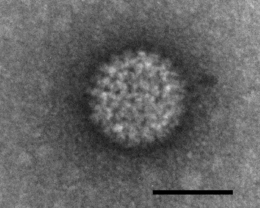
Bluetongue virus under the electron microscope. The marking corresponds to 50 nm
_(720p).webm.jpg)
Play media file Video: What are viruses?
Exploration History
As late as the middle of the 19th century, the term virus was used merely as a synonym for "poison" or "miasma". Only since the late 19th century have viruses been known as a biological entity in their own right. However, the descriptions of viral diseases are much older, as are the first methods of treatment. A legal text from Mesopotamia dating from around 1780 BC has survived which deals with the punishment of a man whose dog, probably infested with rabies, bites and thereby kills a human being (Codex Eshnunna §§ 56 and 57). Representations are known from Egyptian hieroglyphics which presumably show the consequences of a polio infection.
The term "virus" was first used by Cornelius Aulus Celsus in the first century BC. He described the saliva by which rabies was transmitted as "poisonous". In 1882, during experiments with tobacco mosaic disease, Adolf Mayer unwittingly transmitted the viral pathogen for the first time by transferring the sap of infected plants to healthy plants, thus also causing the disease in the latter.
This transmission was already associated with the word virus in the 18th century. Thus, in an obituary of a doctor, the London Times describes his viral infection: while sewing up a dissected corpse, he had pricked his hand, "which introduced some of the virus matter, or, in other words, inoculated him with putridity".
Independent of Mayer, Dimitri Iwanowski demonstrated in an experiment in 1892 that mosaic disease in tobacco plants could be triggered by a substance that could not be removed by filtration using bacteria-proof filters (Chamberland filters) and whose particles therefore had to be significantly smaller than bacteria. Iwanowski suspected a poison as the trigger of the disease. Martinus Willem Beijerinck contradicted this after observing that especially the leaves still in growth were affected by the disease: "While a poison would equally penetrate the already existing cells, the viruses obviously need cell division to unfold."
The first detection of an animal virus was achieved in 1898 by Friedrich Loeffler and Paul Frosch, who discovered the foot-and-mouth disease virus (see also virological diagnostics). The size of many viruses was determined in the 1930s by William Joseph Elford using ultrafiltration methods.
The oldest - indirect - evidence so far for a disease caused by viruses was derived from the deformed bones of a 150-million-year-old small bipedal dinosaur (Dysalotosaurus lettowvorbecki) kept in the Berlin Museum für Naturkunde, which showed symptoms of osteodystrophia deformans attributed to infection with paramyxoviruses.
See also: History of Virology
Properties
Viruses have structures that carry genetic information. But they do not have a metabolism, cannot convert energy and are not able to build proteins. However, the formation of these structures and their reproduction is possible under certain circumstances with the functioning metabolism in the cell of a living organism. The information necessary for this, especially for protein synthesis, is carried by the virus on its nucleic acid (DNA or RNA). Essentially, a virus is a nucleic acid whose information can control the metabolism of a host cell in such a way that viruses are created again. Replication of the viral nucleic acid occurs within the host cell, as does the assembly of viral proteins by ribosomes in the cytoplasm of the cell to further equip the viral particles (virions). The lipids of any viral envelope of the virion also originate from the host cell.
Viruses come in two forms:
- First, as a nucleic acid in the cells of the host. The nucleic acid contains the information for its replication and reproduction of the second form of the virus. In this manifestation is distinguished between DNA viruses and RNA viruses, depending on whether their genetic material is stored as DNA or RNA.
- Second, as a virion that is shed from host cells and allows spread to other hosts.
With regard to the spread and effect in their respective reservoir host and, if applicable, also intermediate host, the virus species often differ very clearly from each other in the characteristics of contagiosity, infectivity and pathogenicity or virulence.
In general, RNA viruses are much more variable than DNA viruses due to the higher error rate of RNA polymerases, as their RNA polymerase usually does not have a proof-reading exonuclease function. An exception to this is the Nidovirales, which have a proof-reading function with the exoribonuclease ExoN, making the genome size somewhat less limited. Due to the high mutation rate, RNA viruses do produce more defective, non-infectious viral particles, which is referred to as a fitness cost due to the reduction in function. However, they can also adapt more rapidly to new hosts or intermediate hosts in the course of immune evasion, as well as escape the immune response by escape mutation.
Features of virions
A virus particle outside cells is called a virion (plural viria, virions). Virions are particles that contain nucleic acids - either deoxyribonucleic acids (DNA) or ribonucleic acids (RNA) - and usually have an enclosing protein capsule (capsid). However, a capsule is absent in the influenza virus, for example, which has a ribonucleoprotein instead. Some virions also have an envelope formed by a biomembrane whose lipid bilayer is interspersed with viral membrane proteins. This is called the viral envelope. Viruses that temporarily have a viral envelope in addition to the capsid until the replication phase begins are referred to as enveloped, while viruses without such an envelope are referred to as non-enveloped. Some virions have other additional components.
The diameter of virions ranges from about 15 nm (e.g. Circoviridae) to 440 nm (Megavirus chilensis). Virions are significantly smaller than bacteria, but somewhat larger than viroids, which have neither a capsid nor a viral envelope.
The protein capsid can have different shapes, for example icosahedral, isometric, helical or bullet-shaped.
Serologically distinguishable variations of a virus are called serotypes.
Virions serve to spread the viruses. They penetrate (infect) the host cells completely or partially (at least their nucleic acid). After that, the host's metabolism starts the multiplication of the viral nucleic acid and the production of the other virion components.
· 
Adenovirus, model of capsid of virion
· 
Schematic of an icosahedral viral capsid
· 
Symmetry of a conical virus capsid
· 
Bunyaviridae, scheme of the structure
· 
Schematic cross section of a lambda phage (virus family Siphoviridae)
· 
Scheme of the structure of Arenaviridae
· 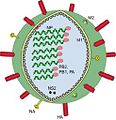
Virion of an influenza virus
· 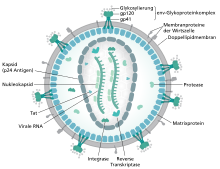
HIV virion
· 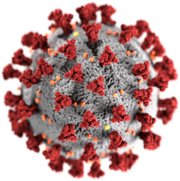
3D graphic of the SARS-CoV-2 virion (coloured model)
Systematic position
Viruses are essentially mere material programs for their own reproduction in the form of a nucleic acid. They possess specific genetic information, but not the synthesis apparatus necessary for their replication. Whether viruses can be called living beings depends on the definition of life. To date, there is no universally accepted, unchallenged definition. Most scientists do not classify viruses as living beings - although the scientific debate is still ongoing, as, for example, the genome size of the Cafeteria-roenbergensis virus is beginning to blur the distinction based on the size of the genome.
Viruses are also not normally considered parasites because parasites are living organisms. Some scientists nevertheless consider viruses to be parasites because they infect a host organism and use its metabolism for their own reproduction. These researchers define viruses as "obligate intracellular parasites" (life forms that are always parasites within a cell) that consist of at least one genome and require a host cell to replicate. It can be agreed, regardless of classification as living or non-living, that the behavior of viruses is very similar to that of common parasites. Viruses, like prions, functionless DNA sequences and transposons, can be described as "parasitic" in this sense.
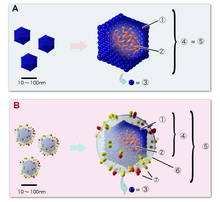
virion assembly
Questions and Answers
Q: What is a virus?
A: A virus is a tiny parasite that can only be seen under an electron microscope. It consists of a protein coat which covers a string of nucleic acid, usually RNA or DNA.
Q: What does virology study?
A: Virology studies viruses and their effects on living organisms.
Q: How do viruses reproduce?
A: Viruses reproduce by getting their nucleic acid strand into either a prokaryote or eukaryote cell. The RNA or DNA strand then takes over the cell machinery to reproduce copies of itself and the protein coat, before bursting open and spreading the newly created viruses.
Q: Are there any free-living viruses?
A: No, all viruses are parasites that must live inside other living things in order to reproduce.
Q: What types of diseases can be caused by viruses?
A: Viruses can cause many types of diseases such as polio, ebola and hepatitis.
Q: How do vaccines work against viral infections?
A: Vaccines give an artificially acquired immunity to the specific viral infection, however some viruses (including those causing AIDS and viral hepatitis) escape from these immune responses and cause chronic infections.
Q: Can antibiotics be used against viruses?
A: No, antibiotics have no effect on viruses but there are some other drugs which can be used against them.
Search within the encyclopedia